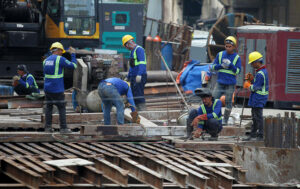Infrastructure spending up nearly 55% in Nov.
INFRASTRUCTURE spending in November rose 54.6% year on year after flagship projects were expedited, the Department of Budget and Management (DBM) said. In a disbursement report, the DBM said spending on infrastructure and other capital outlays rose by P31 billion in November to P87.6 billion. Month on month, infrastructure spending fell 20.36% from P110.0 billion in […]

INFRASTRUCTURE spending in November rose 54.6% year on year after flagship projects were expedited, the Department of Budget and Management (DBM) said.
In a disbursement report, the DBM said spending on infrastructure and other capital outlays rose by P31 billion in November to P87.6 billion.
Month on month, infrastructure spending fell 20.36% from P110.0 billion in October.
The DBM said the Department of Public Works and Highways (DPWH) drove spending with its take up of funding for flagship projects.
“Significant disbursements were also made by the DPWH for completed projects and ongoing contracts from the prior year’s budget,” it said.
The DBM also attributed the increased infrastructure spending in November to the capital outlay projects of state universities and colleges.
It also noted the P3.2-billion disbursement for DPWH’s counterpart funding to foreign-assisted projects, specifically for the Light Rail Transit (LRT) Line 1 South (Cavite) Extension Project and LRT Line 2 East Extension Project.
In the first 11 months, infrastructure spending rose 15.5% to P1.18 trillion.
The National Government is “optimistic” it will exceed the infrastructure target for 2024, which was set at P1.472 trillion, equivalent to 5.6% of gross domestic product, the DBM said.
“This should sustain the strong growth of the construction sector and related services or industries and consequently, helped buoy the economic performance last year,” the DBM said.
The National Economic and Development Authority (NEDA) has said that the government completed seven priority infrastructure projects in 2024.
For 2025, it expects 13 infrastructure flagship programs to be completed.
Terry L. Ridon, convenor of think tank InfraWatch, said the November spending increase was due to a more efficient disbursement process and cooperation between the DBM and infrastructure agencies.
Rizal Commercial Banking Corp. Chief Economist Michael L. Ricafort said the sharp year-on-year increase in infrastructure spending was influenced by the need to push spending before the midterm election spending freeze kicks in.
He said the series of typhoons in the last months of 2024 also unlocked repair or rehabilitation funding.
“In view of the election ban on some infrastructure spending (but there are those exempted) the voters would like to see results in terms of accomplishments of these infrastructure and other government projects,” Mr. Ricafort told BusinessWorld over the weekend.
Ahead of the May 12 elections, the Commission on Elections will ban on public works spending starting March 28, with the freeze running for 45 days.
He said the “timely approval” of spending for more infrastructure projects in the next few months will help accelerate the economy, as will election-related spending by candidates.
Mr. Ridon urges the government to expedite the rollout of infrastructure projects to avoid them being disrupted by the election ban.
“Any delay in implementation means delayed road and bridge repairs and new projects pushed towards the middle or end of the year,” he said. — Aubrey Rose A. Inosante


















